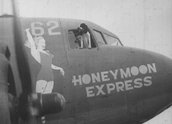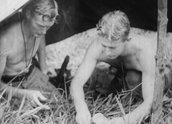


Jungle Patrol (1944)
Synopsis
Eight Australian soldiers leave Port Moresby in New Guinea on an American C-47 transport. They are returning to their unit, pushing the Japanese back along Shaggy Ridge, part of the Finisterre Range, west of Lae, in 1943. The soldiers land at Dumpu airstrip, ‘the Allied airstrip nearest to Tokyo’. The men begin a hard slog along the Ramu Valley, through tall kunai grass and swamp, then a hot climb up to their unit, 5000 feet above the valley floor. Once re-established, they begin patrolling, looking for the enemy. A Japanese machine gun concealed in a bunker opens fire and is quickly silenced. The Australians check the bodies, then bury them and move on. More Japanese are dug in on a high ridge. After heavy artillery and aerial bombing, Australian troops move forward to clear the stronghold. Their objective taken, they dig in and prepare for the next stage of the battle for Shaggy Ridge.
Curator’s notes
Jungle Patrol is one of the most effective and exciting Australian propaganda films of the Second World War. According to Bill Carty, who shot a large part of it, it was the first and only two-reel documentary of Australia’s wartime production. Most newsreels were less than ten minutes. Jungle Patrol ran almost 20 minutes, which may be a sign of the importance it was given by the government, through the Department of Information. Like Kokoda Front Line! (1942) there was a political background to its making – a desire to redress a perceived lack of credit in American propaganda for Australian efforts in the Pacific war.
Tom Gurr was credited as writer and director, but it was a collaborative effort with two of Australia’s best newsreel cameramen, Bill Carty and Bill Trerise. Gurr had worked with Cinesound Review writing the commentary for newsreels until 1933 when he left to join Associated Newspapers. By 1938, he was editor-in-chief of The Sunday Telegraph and responsible for several magazines. He took leave to work on Jungle Patrol without pay, as a contribution to the war effort.
Film historian Graham Shirley interviewed Tom Gurr in 1991 for an oral history, held by the National Film and Sound Archive. In that interview, Gurr says he was approached by Norman McAuley of the DOI to make a film that would show Australians actually fighting the Japanese. The Allied commander in the South-West Pacific, General Douglas Macarthur, had a full staff making public relations films that gave little kudos to Australian efforts.
We provided two thirds of the infantry in New Guinea. If we had a win it was called an Allied victory; if the Americans had a win, and they had their share, it was called a great American victory. That was making us all feel a bit tensed up about the whole thing, right from the very top of Australia down. They thought it would be a good idea to show that Australians were fighting the Japs. They asked me if I would do it and I said yes, but I would take my own cameramen and no instructions from anybody … Carty and I worked out this (concept of) getting a patrol together.
At the headquarters of the 7th Division in the Ramu Valley, Gurr met the Australian commanding officer, Lieutenant-General George Vasey, who insisted that the film had to be ‘dinkum’, no faking. Gurr assured him it would be. The next morning, three battalions were paraded and Gurr selected men to make up a patrol. These were all from the 14th, 16th, and 27th battalions of the 21st Brigade, 7th Division, AIF. Gurr found out later they were all from Victoria, South Australia and Tasmania.
I walked up and down. You, you, you, (based on) size, shape, look. They were all veterans. They had been fighting in Syria and in the Owen Stanley Ranges in New Guinea. I selected them because no two looked the same and they were all dinkum Australian soldiers. They had all been through operations together and they all knew each other.
Bill Carty and Bill Trerise were DOI cameramen, and had been old friends. Trerise taught Carty how to use a camera in the early 1920s when both were making newsreels. Both worked at Cinesound in the 1930s, before the war. By late 1943, Carty had been in New Guinea for a year, shooting newsreels in various operations (notably the terrible battles at Buna and Gona, after Kokoda). In his autobiography, Flickers of History (1999), he says he recommended Trerise to Jack Allan, his boss at the DOI, after Trerise was fired by Movietone, Cinesound’s great rival in the newsreel business. Allan sent Trerise to New Guinea, where Carty was already preparing to shoot Jungle Patrol with Tom Gurr.
On arrival, according to Carty’s account, Trerise told him that he, not Carty, was now chief cameraman. '“Pig’s arse”, was my reply.’ The disagreement became very heated, the two cameramen almost coming to blows. In practice, they had to share the tasks. ‘As it turned out, I spent most of my time on patrols with the troops, while Trerise sat on top of Shaggy Ridge shooting cutaways, the footage that goes in between the main action sequences’, wrote Carty. Whether this is quite fair to Trerise’s contribution is open to question.
The footage they shot is certainly remarkable, no matter who was responsible. The battle for Shaggy Ridge was a slow and brutal action, in impossible terrain, and the film gives a good sense of that. It’s also unusual in that it identifies eight specific soldiers by name, although not by unit (probably for reasons of security). We then follow the eight men from Port Moresby, where they appear to have been on leave, as they are flown back over the mountains to regain their battalion on Shaggy Ridge.
The decision to show the transport in detail may have been an attempt to reassure Australian officials about the safety and efficacy of using American transport planes for large-scale transport of troops. This film was shot shortly after a horrific accident at Port Moresby’s Jackson airfield. On 6 September 1943, US planes had begun flying Australian troops over the ranges to Nadzab, near Lae, as part of the campaign to drive the Japanese out of the Markham and Ramu valleys. This was to be the first time an entire Australian division (the 7th) was deployed entirely by air, rather than by sea or land. On the morning of 7 September, a Liberator bomber clipped trees taking off and crashed into a line of five trucks containing men of the 2/33rd Battalion, who were waiting to be flown to Nadzab. The bomber’s four 500 lb bombs exploded, killing 59 soldiers and drivers, and injuring another 92 Australians.
The film’s narration mentions the ‘mass paratroop descent at Nadzab’, where more than 1000 US service personnel were dropped. That took place on 5 September 1943, the day before the 7th Division troops were flown in. More Australian soldiers died in the accident on 7 September than in the five-month campaign to win Shaggy Ridge. The film’s reassuring and almost jocular tone during the early transport scenes might have been at least partly intended as reassurance. It was probably intended also to inform the Australian public that transport of troops in New Guinea had improved greatly since the rigours of the Kokoda track a year earlier.
The battle scenes on Shaggy Ridge are almost certainly a mixture of re-enactment and actuality. The raid on the Japanese bunker looks like re-creation, simply because the cameraman is too exposed to enemy fire, and because he captures all the explosions going off at exactly the right time. On the other hand, the dead Japanese soldiers look very real, so it is possible that some of the attack footage is also captured as it happened, or just after. The air attack on the wooded ridge in clip three is both real and staged, a very strange situation. It is probably the area known as ‘the Pimple’, the protruding apex of the ridge, one of the main Japanese strongholds. The 2/16th Battalion captured the Pimple on 27 December 1943. Whether this footage was taken that day is hard to determine, but it is unlikely. Gurr says the bombing was arranged by the cameraman, Bill Carty.
I knew the film had to end with something, and so we were aiming at Shaggy Ridge … Just to put some spice into the finish – and this is what organisation is, and what Bill Carty was good at – we had an ‘in’ with the air force, so at a time nominated by us and carrying bombs nominated by us, with especially bright substances wired to the bombs, at bang on noon, over came this flight of Kittyhawks to drop our bombs on the Japs. That is why you saw that lovely line of brilliant explosions, special bombs which we organised.
The film also shows the Australians digging in on the Pimple, soon after capturing it. Bill Trerise, in an oral history interview recorded in 1981, said that Arthur Calwell, the wartime Minister of Information, complimented Trerise on the success of Jungle Patrol. ‘We’ll have to have more films like that’, Calwell is supposed to have said. Trerise agreed, but pointed out that it would be difficult to do them with the sub-standard cameras issued by the department. Calwell then agreed to spend £6000 on new equipment. According to Trerise, this resulted in significant new purchases for Department of Information cameramen – one Mitchell camera, four Bell and Howell Eyemos, and four Cinekodaks.
Jungle Patrol was a great success in Australia, and Gurr says he received great kudos in the US and Britain, after copies reached there. It was used by both the Russian and the British armies as a training film, he claimed. It is less famous than Kokoda Front Line! (1942) but arguably more revealing of the daily work of Australian soldiers on patrol. The action scenes are also closer to being authentic: at least the fighting is filmed on Shaggy Ridge, even if some of it is likely to have been re-created. The voice-over was recorded by a young Australian actor who would become very famous soon after, Peter Finch.
- Overview
- Curator’s notes
- Video 3 clips
- Principal credits
- Find a copy
- Make a comment
- Map
- Add your review



